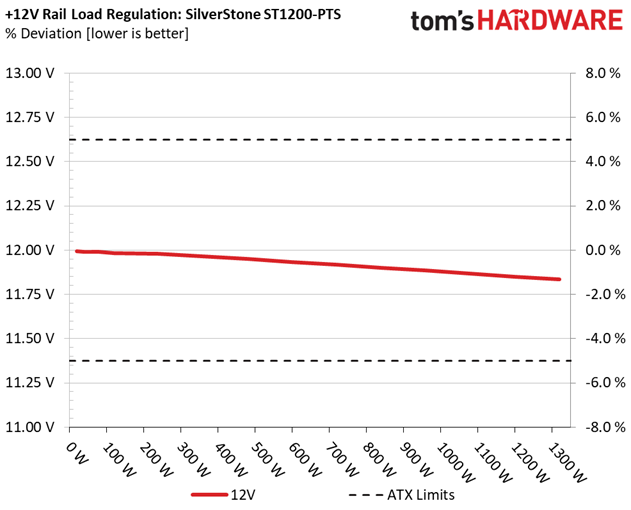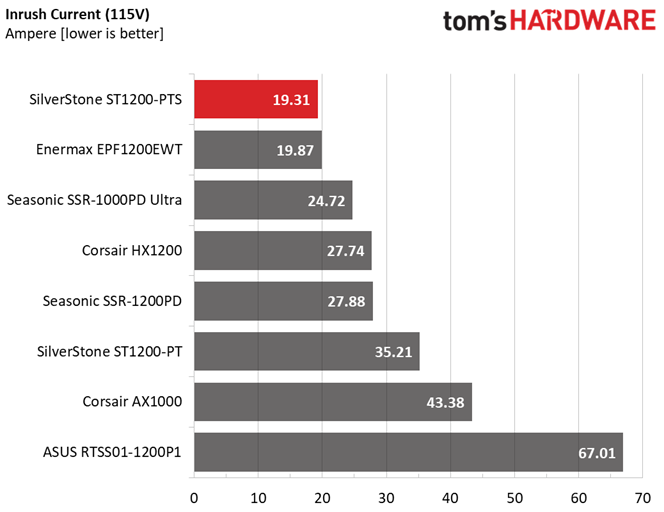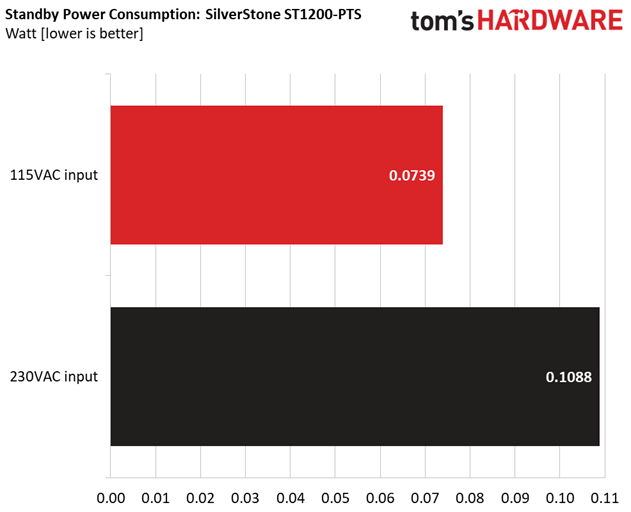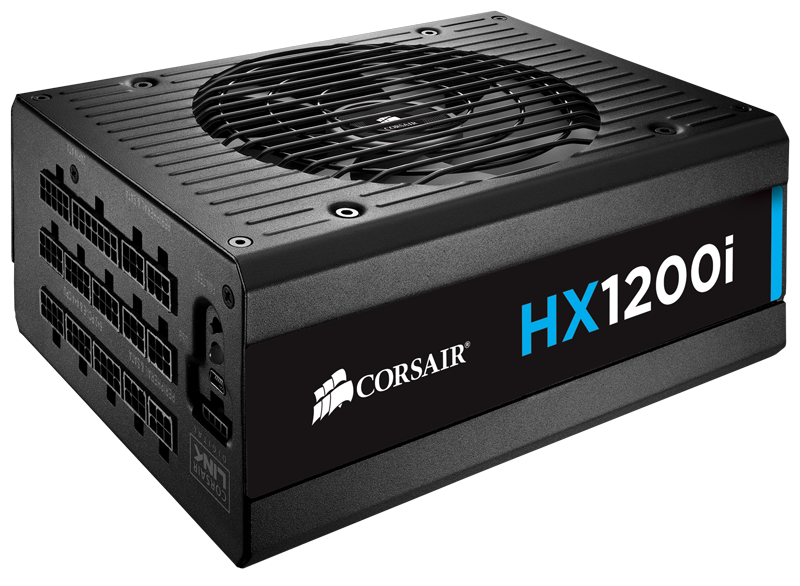SilverStone ST1200-PTS PSU Review: Compact But Powerful
Why you can trust Tom's Hardware
Load Regulation, Hold-Up Time, Inrush Current, Efficiency and Noise
To learn more about our PSU tests and methodology, please check out How We Test Power Supply Units.
Primary Rails And 5VSB Load Regulation
The following charts show the main rails' voltage values recorded between a range of 40W up to the PSU's maximum specified load, along with the deviation (in percent). Tight regulation is an important consideration every time we review a power supply, because it facilitates constant voltage levels despite varying loads. Tight load regulation also, among other factors, improves the system’s stability, especially under overclocked conditions and, at the same time, it applies less stress to the DC-DC converters that many system components utilize.








The load regulation is not tight, in all rails.
Hold-Up Time
Put simply, hold-up time is the amount of time that the system can continue to run without shutting down or rebooting during a power interruption.




The hold-up time does not reach 17ms, as the ATX spec requires and to make matters even worse, the power ok signal is inaccurate. It is a huge disappointment, to see a high-end power supply reporting a "fake" power ok signal to the system's components, making them "believe" that they operate with safe voltages.
Inrush Current
Inrush current, or switch-on surge, refers to the maximum, instantaneous input current drawn by an electrical device when it is first turned on. A large enough inrush current can cause circuit breakers and fuses to trip. It can also damage switches, relays, and bridge rectifiers. As a result, the lower the inrush current of a PSU right as it is turned on, the better.


The SilverStone ST1200-PTS registered inrush currents are among the lowest we have ever measured in a 1200W PSU, especially with 230V input.
Get Tom's Hardware's best news and in-depth reviews, straight to your inbox.
10-110% Load Tests
These tests reveal the SilverStone ST1200-PTS’s load regulation and efficiency levels under high ambient temperatures. They also show how the fan speed profile behaves under under increased operating temperatures.
| Test # | 12V | 5V | 3.3V | 5VSB | DC/AC (Watts) | Efficiency | Fan Speed (RPM) | PSU Noise (dB[A]) | Temps (In/Out) | PF/AC Volts |
|---|---|---|---|---|---|---|---|---|---|---|
| 1 | 8.214A | 1.990A | 1.980A | 0.986A | 120.030 | 89.144% | 940 | 21.5 | 39.48°C | 0.978 |
| 11.984V | 5.026V | 3.329V | 5.072V | 134.648 | 42.26°C | 115.10V | ||||
| 2 | 17.433A | 2.991A | 2.987A | 1.186A | 239.737 | 92.018% | 943 | 21.5 | 40.96°C | 0.993 |
| 11.979V | 5.016V | 3.316V | 5.058V | 260.534 | 44.56°C | 115.10V | ||||
| 3 | 27.017A | 3.496A | 3.478A | 1.388A | 359.236 | 92.952% | 946 | 21.6 | 41.05°C | 0.996 |
| 11.964V | 5.007V | 3.306V | 5.044V | 386.474 | 45.65°C | 115.10V | ||||
| 4 | 36.696A | 4.002A | 4.004A | 1.591A | 479.680 | 92.604% | 951 | 21.7 | 41.91°C | 0.997 |
| 11.949V | 4.998V | 3.296V | 5.029V | 517.989 | 47.82°C | 115.10V | ||||
| 5 | 46.032A | 5.014A | 5.025A | 1.795A | 599.814 | 92.257% | 956 | 22.0 | 42.03°C | 0.998 |
| 11.933V | 4.988V | 3.284V | 5.015V | 650.155 | 48.57°C | 115.10V | ||||
| 6 | 55.395A | 6.029A | 6.051A | 2.001A | 719.957 | 91.685% | 1011 | 23.7 | 42.65°C | 0.999 |
| 11.917V | 4.978V | 3.272V | 4.999V | 785.249 | 50.27°C | 115.09V | ||||
| 7 | 64.747A | 7.049A | 7.089A | 2.207A | 839.669 | 91.037% | 1644 | 35.4 | 43.51°C | 0.999 |
| 11.901V | 4.967V | 3.259V | 4.984V | 922.342 | 52.05°C | 115.09V | ||||
| 8 | 74.192A | 8.076A | 8.134A | 2.416A | 960.114 | 90.276% | 2169 | 42.5 | 43.97°C | 0.999 |
| 11.884V | 4.955V | 3.245V | 4.969V | 1063.527 | 53.23°C | 115.08V | ||||
| 9 | 84.007A | 8.596A | 8.657A | 2.420A | 1079.426 | 89.554% | 2189 | 42.6 | 44.42°C | 0.999 |
| 11.867V | 4.945V | 3.235V | 4.960V | 1205.335 | 54.61°C | 115.07V | ||||
| 10 | 93.675A | 9.120A | 9.213A | 3.042A | 1199.868 | 88.617% | 2192 | 42.7 | 45.55°C | 0.999 |
| 11.851V | 4.936V | 3.224V | 4.933V | 1353.995 | 56.74°C | 115.06V | ||||
| 11 | 103.953A | 9.133A | 9.236A | 3.048A | 1319.885 | 87.644% | 2196 | 42.7 | 46.95°C | 0.999 |
| 11.834V | 4.928V | 3.215V | 4.923V | 1505.969 | 59.02°C | 115.05V | ||||
| CL1 | 0.142A | 14.002A | 13.996A | 0.000A | 117.534 | 86.273% | 1022 | 24.2 | 42.17°C | 0.981 |
| 11.985V | 4.992V | 3.282V | 5.090V | 136.235 | 48.47°C | 115.11V | ||||
| CL2 | 100.003A | 1.001A | 0.998A | 1.000A | 1198.758 | 88.973% | 2202 | 42.7 | 45.64°C | 0.999 |
| 11.855V | 4.964V | 3.258V | 5.002V | 1347.333 | 56.51°C | 115.06V |
The PSU doesn't have a problem operating at high ambient temperatures, despite the official 40°C rating. Even with 110% of its max-rated-output with 47°C ambient the unit performed well. Moreover, the PF readings are high in all tests, proving the effectiveness of the interleaved APFC converter.
We conducted the same tests with 100V input and we faced a problem in the tests #10 and #11. The PSU refused to operate properly with the 12V rail being close to 11V and after a couple of seconds it shut down. This means that the SilverStone ST1200-PTS cannot operate properly with 100V input, under full load at least, although SilverStone states that this unit supports an input voltage range of 100V to 264V.
20-80W Load Tests
In the following tests, we measure the ST1200-PTS's efficiency at loads significantly lower than 10 percent of its maximum capacity (the lowest load the 80 PLUS standard measures). This is important for representing when a PC is idle, with power-saving features turned on.
| Test # | 12V | 5V | 3.3V | 5VSB | DC/AC (Watts) | Efficiency | Fan Speed (RPM) | PSU Noise (dB[A]) | PF/AC Volts |
|---|---|---|---|---|---|---|---|---|---|
| 1 | 1.204A | 0.496A | 0.477A | 0.196A | 19.529 | 68.815% | 928 | 21.3 | 0.702 |
| 11.993V | 5.034V | 3.340V | 5.103V | 28.379 | 115.12V | ||||
| 2 | 2.473A | 0.993A | 0.988A | 0.393A | 39.953 | 79.212% | 935 | 21.4 | 0.891 |
| 11.992V | 5.033V | 3.337V | 5.096V | 50.438 | 115.11V | ||||
| 3 | 3.671A | 1.490A | 1.469A | 0.590A | 59.416 | 83.795% | 936 | 21.4 | 0.930 |
| 11.991V | 5.031V | 3.334V | 5.088V | 70.906 | 115.11V | ||||
| 4 | 4.939A | 1.988A | 1.979A | 0.787A | 79.801 | 85.985% | 938 | 21.5 | 0.959 |
| 11.989V | 5.029V | 3.331V | 5.081V | 92.808 | 115.10V |
Under light loads the fan spins at low speeds, keeping the noise below 22 dB(A) so it is practically inaudible. The registered efficiency is satisfactory, given the PSU's 1200W capacity.
Efficiency
Next, we plotted a chart showing the SilverStone ST1200-PTS’s efficiency at low loads, and loads from 10 to 110 percent of its maximum-rated capacity. The higher a PSU’s efficiency the less energy goes wasted leading to a reduced carbon footprint, besides lower electricity bills.




This is a highly-efficient design, going toe-to-toe with the Seasonic Prime Platinum with 1kW max power. With light loads, the ST1200-PTS performs well achieving the highest overall efficiency among 1200W units.
5VSB Efficiency
| Test # | 5VSB | DC/AC (Watts) | Efficiency | PF/AC Volts |
|---|---|---|---|---|
| 1 | 0.100A | 0.511 | 72.896% | 0.032 |
| 5.107V | 0.701 | 115.09V | ||
| 2 | 0.250A | 1.276 | 78.378% | 0.074 |
| 5.103V | 1.628 | 115.09V | ||
| 3 | 0.550A | 2.802 | 79.989% | 0.152 |
| 5.094V | 3.503 | 115.10V | ||
| 4 | 1.000A | 5.082 | 80.821% | 0.250 |
| 5.081V | 6.288 | 115.09V | ||
| 5 | 1.500A | 7.601 | 80.298% | 0.334 |
| 5.067V | 9.466 | 115.10V | ||
| 6 | 3.000A | 15.072 | 78.174% | 0.474 |
| 5.024V | 19.280 | 115.10V |
Satisfactory efficiency results from the 5VSB rail.


Power Consumption In Idle And Standby
| Mode | 12V | 5V | 3.3V | 5VSB | Watts | PF/AC Volts |
|---|---|---|---|---|---|---|
| Idle | 11.991V | 5.032V | 3.341V | 5.109V | 10.683 | 0.219 |
| 115.1V | ||||||
| Standby | 0.074 | 0.003 | ||||
| 115.1V |


Fan RPM, Delta Temperature, And Output Noise
All results are obtained between an ambient temperature of 37°C (98.6°F) to 47°C (113°F).
At up to 700W load the cooling fan spins at low RPMs. With higher loads, it quickly increases its speed and, with 960W load, it is close to 2200 RPM with the noise exceeding 42 dB(A).
The following results were obtained at 30°C (86°F) to 32°C (89.6°F) ambient temperature.
With up to 800W load the unit is silent. It takes more than 900W load to enter the 30-35 dB(A) range while, with more than 1000W, it passes the 40 dB(A) mark.
MORE: Best Power Supplies
MORE: How We Test Power Supplies
MORE: All Power Supply Content
Current page: Load Regulation, Hold-Up Time, Inrush Current, Efficiency and Noise
Prev Page Specifications and Part Analysis Next Page Protection Features, DC Power Sequencing, Cross-Load Tests and Infrared Images
Aris Mpitziopoulos is a contributing editor at Tom's Hardware, covering PSUs.






